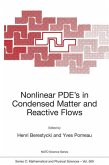The aim of this book is to give a self-contained introduction to the mathe matical analysis and physical explanations of some basic nonlinear wave phe nomena. This volume grew out of lecture notes for graduate courf;!es which I gave at the University of Alberta, the University of Saskatchewan, ·and Texas A&M University. As an introduction it is not intended to be exhaustive iQ its choice of material, but rather to convey to interested readers a basic; yet practical, methodology as well as some of the more important results obtained since the 1950's. Although the primary purpose of this volume is to serve as a textbook, it should be useful to anyone who wishes to understand or conduct research into nonlinear waves. Here, for the first time, materials on X-ray crystallography and the forced Korteweg-de Vries equation are incorporated naturally into a textbook on non linear waves. Another characteristic feature of the book is the inclusion of four symbolic calculation programs written in MATHEMATICA. They emphasize outcomes rather than numerical methods and provide certain symbolic and nu merical results related to solitons. Requiring only one or two commands to run, these programs have user-friendly interfaces. For example, to get the explicit expression of the 2-soliton of the Korteweg-de Vries equation, one only needs to type in soliton[2] when using the program solipac.m.








